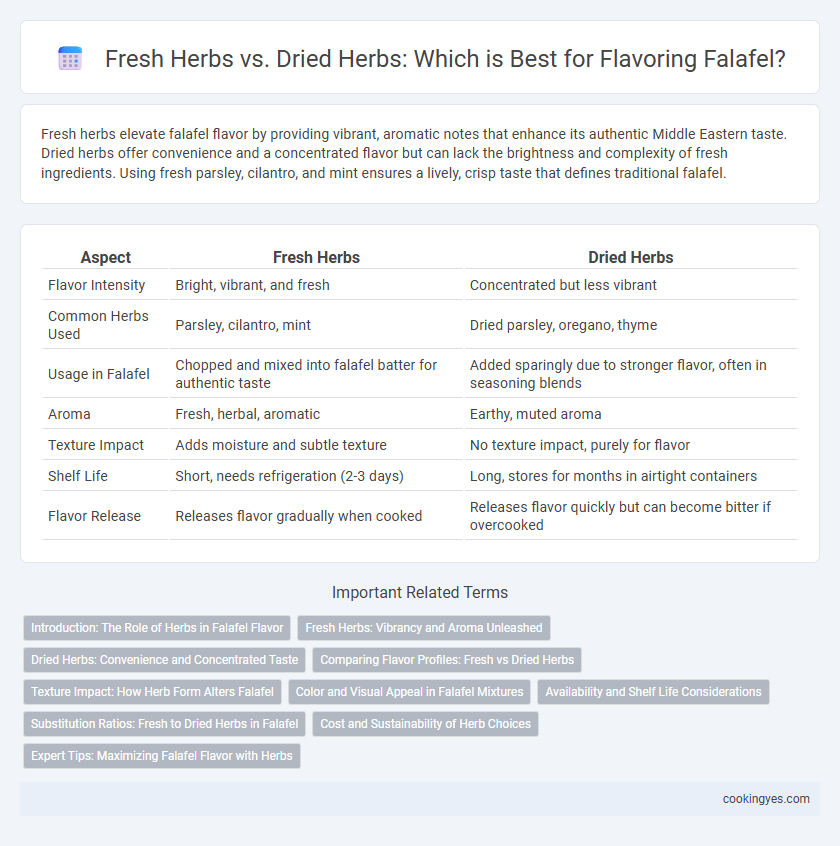Fresh herbs elevate falafel flavor by providing vibrant, aromatic notes that enhance its authentic Middle Eastern taste. Dried herbs offer convenience and a concentrated flavor but can lack the brightness and complexity of fresh ingredients. Using fresh parsley, cilantro, and mint ensures a lively, crisp taste that defines traditional falafel.
Table of Comparison
| Aspect | Fresh Herbs | Dried Herbs |
|---|---|---|
| Flavor Intensity | Bright, vibrant, and fresh | Concentrated but less vibrant |
| Common Herbs Used | Parsley, cilantro, mint | Dried parsley, oregano, thyme |
| Usage in Falafel | Chopped and mixed into falafel batter for authentic taste | Added sparingly due to stronger flavor, often in seasoning blends |
| Aroma | Fresh, herbal, aromatic | Earthy, muted aroma |
| Texture Impact | Adds moisture and subtle texture | No texture impact, purely for flavor |
| Shelf Life | Short, needs refrigeration (2-3 days) | Long, stores for months in airtight containers |
| Flavor Release | Releases flavor gradually when cooked | Releases flavor quickly but can become bitter if overcooked |
Introduction: The Role of Herbs in Falafel Flavor
Fresh herbs such as parsley and cilantro provide bright, vibrant flavors that enhance the traditional taste of falafel, adding essential freshness and complexity. Dried herbs, while more concentrated, often lack the delicate aroma and lively notes that fresh herbs impart, potentially resulting in a less dynamic flavor profile. Incorporating fresh herbs is crucial for achieving the authentic, herbaceous character fundamental to classic falafel.
Fresh Herbs: Vibrancy and Aroma Unleashed
Fresh herbs such as parsley, cilantro, and mint deliver a vibrant flavor and intense aroma that dried herbs cannot replicate in falafel recipes. The essential oils in fresh herbs enhance the overall freshness and complexity, creating a more authentic and lively taste profile. Using fresh herbs brightens the traditional falafel blend, resulting in a fragrant and appetizing dish.
Dried Herbs: Convenience and Concentrated Taste
Dried herbs offer concentrated flavor essential for authentic falafel seasoning, providing a robust herbal profile that enhances every bite. Their long shelf life ensures convenience and consistent taste without frequent replacement, making them ideal for busy kitchens. Using dried herbs like parsley, cilantro, or dill intensifies falafel's aromatic essence while saving preparation time compared to fresh herbs.
Comparing Flavor Profiles: Fresh vs Dried Herbs
Fresh herbs like parsley and cilantro deliver a vibrant, bright flavor that enhances the authentic taste of falafel, infusing it with a lively, garden-fresh aroma. Dried herbs provide a more concentrated, earthy flavor but can lack the subtle, crisp notes that fresh herbs offer, sometimes resulting in a muted and less dynamic taste. Using fresh herbs maximizes the traditional falafel flavor profile, while dried herbs may serve as a convenient alternative with a deeper but less nuanced herbaceousness.
Texture Impact: How Herb Form Alters Falafel
Fresh herbs like parsley and cilantro provide a vibrant, moist texture that enhances the falafel's freshness and juiciness, creating a light and fluffy interior. Dried herbs, while offering concentrated flavor, tend to absorb moisture and can lead to a denser falafel texture with less herbaceous brightness. Choosing between fresh and dried herbs directly affects the falafel's mouthfeel and overall flavor profile, emphasizing either a tender bite or a more compact, robust consistency.
Color and Visual Appeal in Falafel Mixtures
Fresh herbs such as parsley and cilantro impart vibrant green hues that enhance the visual appeal of falafel mixtures, creating an appetizing contrast against the golden brown crust. Dried herbs tend to lose their bright coloration during cooking, resulting in a duller, less visually striking falafel. Using fresh herbs not only intensifies flavor but also contributes a natural, lively color that elevates the dish's overall presentation.
Availability and Shelf Life Considerations
Fresh herbs like parsley and cilantro offer vibrant flavors essential for authentic falafel but have limited availability and a short shelf life of about one week when stored properly. Dried herbs provide convenience and long shelf life, lasting up to one year without refrigeration, making them a practical alternative when fresh options are scarce. The choice between fresh and dried herbs affects not only flavor intensity but also storage logistics and ingredient accessibility for falafel preparation.
Substitution Ratios: Fresh to Dried Herbs in Falafel
Using fresh herbs in falafel enhances the dish's vibrant, aromatic flavor with a bright, lively taste profile, while dried herbs offer concentrated intensity but can be more pungent. The common substitution ratio is 3:1, meaning three parts fresh herbs equal one part dried herbs, ensuring balanced seasoning without overpowering the falafel. For example, if a recipe calls for 1 tablespoon of fresh parsley, use 1 teaspoon of dried parsley to maintain optimal flavor.
Cost and Sustainability of Herb Choices
Fresh herbs like parsley and cilantro provide vibrant flavor to falafel while often costing more and requiring increased water and energy resources for cultivation. Dried herbs offer a cost-effective, longer-lasting alternative with reduced environmental impact due to less frequent harvesting and transportation needs. Choosing dried herbs supports sustainability by minimizing waste and conserving resources without compromising the essential taste profile of falafel.
Expert Tips: Maximizing Falafel Flavor with Herbs
Fresh herbs like parsley and cilantro provide vibrant, bright flavors and a moist texture that elevate falafel's taste profile. Dried herbs concentrate flavor, offering a more intense, earthy note, but should be added sparingly to avoid overpowering the dish. Experts recommend combining fresh herbs for brightness with a pinch of dried herbs to create a balanced, complex flavor that maximizes falafel's aromatic appeal.
Fresh Herbs vs Dried Herbs for falafel flavoring Infographic

 cookingyes.com
cookingyes.com